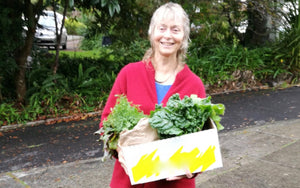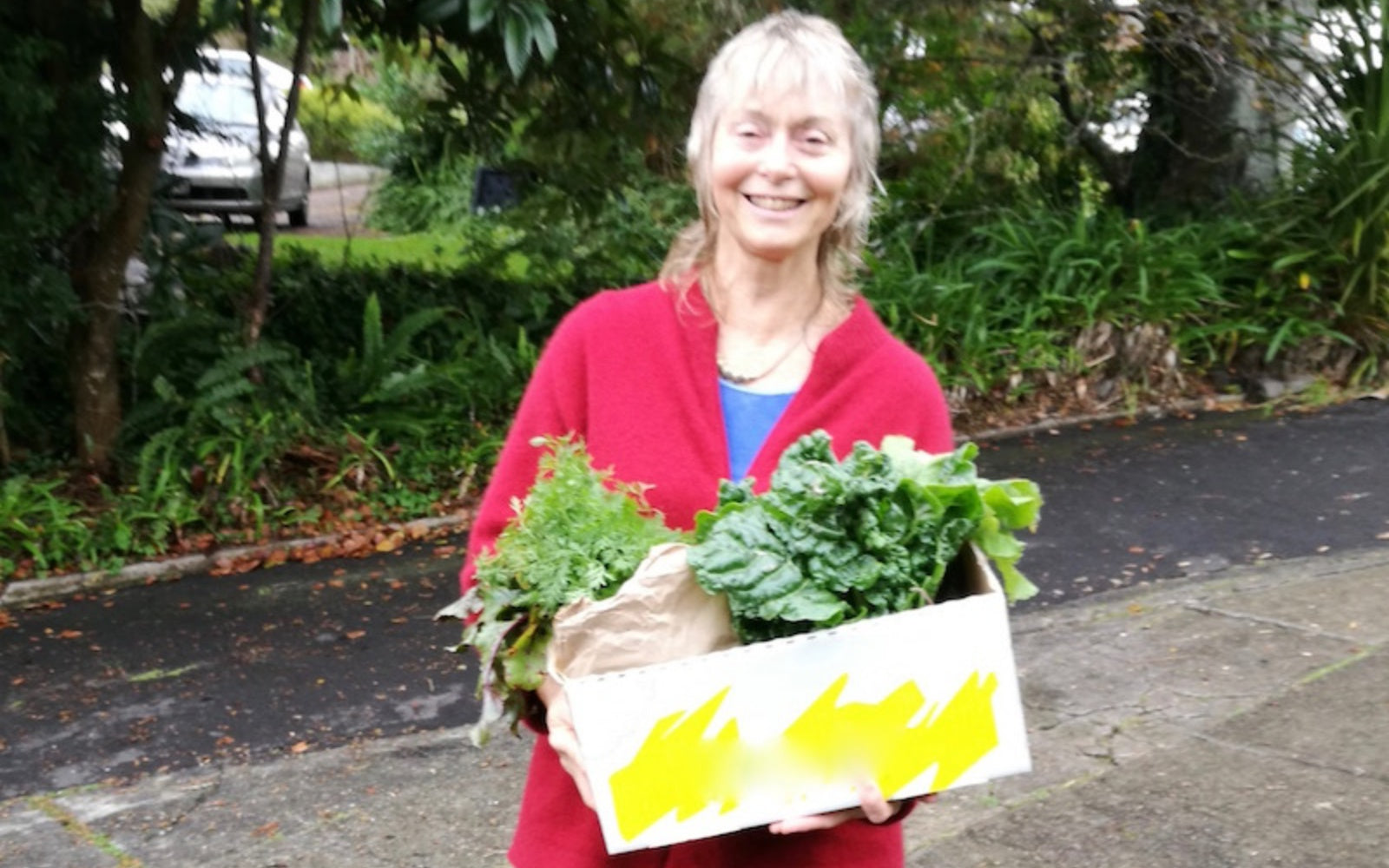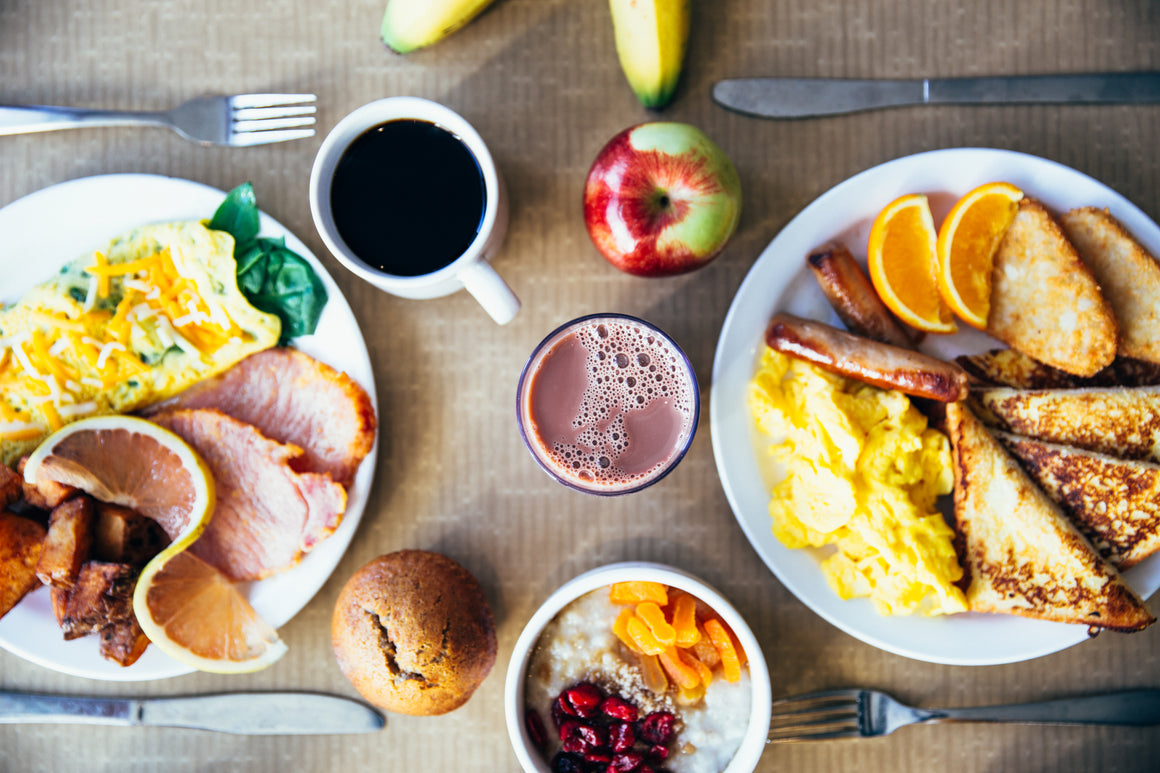The economics of local food in New Zealand. Alice Bulmer.

This is a post about local food. I love eating food grown in my region, the Waikato in New Zealand’s heartland.
I don’t think local food is just an idealistic middle class fad, as some cynical commentators claim.
But the local food economy is an interesting and paradoxical phenomenon, particularly in New Zealand, which has always focused on export. Producing for local markets requires determination and creativity.
I’ve just arrived home from my weekly trip to the Hamilton Farmers’ Market. My husband Matthew and I go there on Sunday morning most weekends. We typically spend something like $100, mainly on food ingredients and fresh produce: vegetables, fruit, meat, fish, free-range eggs, milk, honey, butter. We could easily spend more than that, especially if we bought prepared food.

If you think this is a lot, an average NZ household spends something like $230 per week on food, according to an article I found on Stuff. None of the food we buy at the market costs more than the equivalent at other places – I’ve checked.
We’ve been shopping at the farmers’ market regularly for more than ten years, since we first moved to Hamilton. During that time the market has been in four different places, and stallholders have come and gone.
Some of the food we buy at the market because we can’t get it anywhere else, like the superb Soggy Bottom bacon. Some we buy because it’s convenient, we know the stallholders and the food is fresh, seasonal and excellent quality.
What do I mean by local food?
Local food is grown and consumed locally. This isn’t just about promoting particular products, producers or events, although the events spearheaded by the organisation Waikato Food Inc are highlighting local food culture and gaining media attention.
Restaurants and chefs are also part of the local food movement, as role models. They can provide good markets for local producers.
The local food economy could also include food that isn’t bought and sold – what’s grown in backyards and on lifestyle blocks and in community gardens.

I’m a local food enthusiast, not a purist. I love coffee and chocolate, neither of which will ever be produced in the Waikato (or anywhere else in New Zealand). I make an effort to buy fairtrade and certified organic coffee and chocolate. Here’s a link to my post about Trade Aid, which is a prominent New Zealand fairtrade organization.
Local food is a paradox. New Zealand, and the Waikato region in particular, has abundant quality fresh food. We’re the envy of the world. But we are only just starting to develop a local food economy. New arrivals in the Waikato are often surprised that local farmers’ markets are still in a developing stage. The very idea of a local food economy is something different and new – not just to the Waikato but to New Zealand as a whole. Our central and local governments still haven’t started adjusting policy to reflect this.
For nearly 200 years, since colonization, New Zealand’s economy has been based on food production – but mainly for export, and mainly “raw materials”: milk, meat, etc. New Zealand has an abundance of fertile land and a relatively gentle climate that’s good for growing food. We’re one of very few nations who could feed themselves. But most food we produce is exported, and much food in our supermarkets is imported.
Colonial traditions
As a former colony of the British Empire, we don’t yet have strong local food traditions. Most of what we call “kiwi” food is mid-20th century international produce: weet-bix, tomato sauce, vegemite, etc. Supermarket chains dominate our local food supply, but they don’t generally sell local food. Even the fruit and vegetables come from other regions and other countries. Local producers have told me that it’s hard for small businesses to deal with supermarkets.
Specialist vegetable shops often sell locally grown produce. For example, in Hamilton, Vege King in Fairfield sells vegetables grown in Gordonton. But the shop owners don’t emphasise that their produce is locally grown because their customers don’t ask.

Money in the local economy
The economic impact of supermarket shopping is that all the money we spend there goes out of the local economy, apart from the wages of supermarket workers (which are typically minimum wage or near to that). Whereas money spent at the local farmers’ markets or in shops that stock local produce stays in the local economy.
The cost of transporting food long distances isn’t reflected in supermarket prices. New Zealand products are sold in Europe for similar or lower prices than we pay in New Zealand, and vice versa. But food that’s exported and imported contributes to GDP. Whereas food grown and consumed locally doesn’t.
Supply chains and commodity markets
The longer the supply chain, the less money goes to the people who actually produce the food. I learned this from working for New Zealand fair trade organization Trade Aid. Producers of meat or milk may sometimes get good returns, but at other times are victims of fluctuations of commodity prices on the global market, which don’t really have much to do with competition. This is just the way commodity markets work. They’re not designed to benefit producers.
The other implication of the supermarket model is that supermarkets use their buying power to pay food producers as little as possible. What the producers get often doesn’t reflect a reasonable return for their investment. And the price the supermarkets sell the food for doesn’t reflect what they paid for it.
Export markets are not fair trade, especially for small producers. Currency exchange shifts, regulation changes, weather patterns etc, can wipe out a season’s income. Also there can be a lag of many months between supply and payment, which makes things very difficult for a small business. Export can be profitable, but can also be very problematic.
Shortening the food chain is better for both producers and consumers, resulting in fresher food and stronger community relationships.
Thinking local
Thinking about food in terms of a local food economy involves a change in buying patterns – and also a change in eating patterns. Many consumers are not accustomed to local food production. I’ve heard people complain that the farmers’ market is too expensive – they expect it to be cheaper than their local vegetable shop or supermarket. If I was a food producer selling at the market, I’d find this very annoying and discouraging.
Also, people aren’t used to eating what’s in season. Supermarkets stock out of season vegetables and fruit that have been transported from the northern hemisphere and/or stored for months.
Food writer Michael Pollan says that people are used to food being very cheap in proportion to other living expenses. He’s writing about middle-class Americans, but this also applies to New Zealanders. In European countries where food quality is prioritized, people typically spend a much higher proportion of their income on fresh food. The New Zealand middle class could afford to spend money on local food (and many people are).
I do sometimes buy fresh food at supermarkets, but mostly as a second choice – if the free-range eggs are sold out at the farmers’ market, for example. And I don’t expect to find local and seasonal food at the supermarket. Although one of my local supermarkets stocks Waikato produced Jersey Girls organic milk.
Local food as social change
Some other factors in local food movements are food sovereignty and food resilience. When enough people regularly spend money in the local food economy, this will build local economies that aren’t dependent on global commodity markets. Throughout New Zealand’s history the boom and bust cycles of global markets has caused economic hardship.
Food sovereignty is an international local food movement based on the right of people to healthy and culturally appropriate food produced through ecologically sound and sustainable methods. Isa Ritchie recently wrote a PhD thesis at Waikato University on food sovereignty, focusing on local food initiatives in Raglan.
New markets
Local food producers need access to a variety of markets. The farmers’ markets work well for some producers, but don’t suit everyone, because of the ongoing time, effort and logistics involved. I’m aware of many small scale growers, in particular producers of tree crops such as nuts and fruit, who don’t find it easy to sell their produce.
In some regions CSA (community supported agriculture) initiatives and local food box delivery schemes supply local produce to urban consumers. There’s a CSA initiative in my hometown, Hamilton – to find out more contact Go Eco.
When we lived in Auckland my family ate our way through a box of certified organic vegetables and fruit, delivered each week from the Kumeu family farm of Des and Aileen Matheson of Eco-Organics. I found the weekly box saved me time. I didn’t have to go to the shops (there was no farmers’ market nearby). It also simplified my decisions about meals – I would just prepare the seasonal vegetables that turned up in the box. (I had to learn some new recipes!)
Some local producers of premium products focus on supplying directly to restaurants, rather than general consumers, for example the Raglan-based Grandad’s Beef company. The online farmers’ market initiative in Taranaki allows consumers to purchase local food online. In the Waikato, a few shops specialize in local produce, for example The Farm Shop in Gordonton and Whatawhata.
Local is fresher
If you’re interested in nutrition and freshness, then buying local is an obvious choice. The further food has been transported, the less fresh it will be. This results in fewer nutrients and less flavour. Supermarket food is typically processed so it will last longer, which reduces the nutritional value. Fresh fruit and vegetables sold in supermarkets have been bred and selected to last for long periods after harvesting, not for flavour or nutrition.
When you buy local food you can meet the producers. This can feel strange, when you’ve been used to buying anonymous food from a supermarket. This promotes community relationships, and it also means you can find out how the food has been grown.
The reason that some large-scale growers can get away with unhealthy farming practices is that consumers can’t see what they are doing. Spraying herbicide on potato leaves before harvest is one example. This is general practice in the potato industry, but Richard Cato, the potato specialist at Waikato Farmers’ Markets, never does this.

Environmental impact
This post is not primarily about environmental issues, but it’s worth noting that environmental costs are not yet included in the global food economy. In particular the environmental costs of long-distance freight – road building, fossil fuel dependence, pollution, etc – is regarded as an “externality”. When this changes, the economics of local food production will look much better.
In New Zealand the environmental impact of intensive dairy farming (land degradation and water pollution) isn’t being factored into the cost of milk.
The economic system and local food producers
Our current economic system doesn’t support production for local markets. I’ve heard anecdotally that banks are reluctant to lend even small amounts for a property that’s described as a small-scale organic farm, whereas if the same property is described as a “lifestyle block with a few fruit trees” that’s a different matter.
The New Zealand horticulture sector is firmly focused on export. Our central and local government are not yet factoring in local food economics as important. They’re still solidly focused on export/ import. In Europe, governments subsidise local food producers.
Recent migrants are often surprised by this. A young French entrepreneur who is developing a food growing business in the Waikato, aimed at local markets, said he keeps being asked if he is planning to export.
For every advocate stating that large scale high tech agribusiness is the only way to feed the world’s population, there are others documenting that small scale local growing can be more productive and much more sustainable. They are two very different economic and environmental paradigms.
Sustainable dairy farming
The Waikato region, where I live, is predominantly large dairy farms, producing milk for export. But I know of several small family farms which are moving towards more sustainable models of dairy farming.
Matamata-based Jersey Girls Organics are producing premium certified organic A2 milk for local markets. It’s not easy for them – amongst other challenges they are required to comply with regulations designed for large global export milk producers. There is no regulatory system for smaller scale businesses.
Some other local small scale dairy farms are Mike and Madeline Moss, who have a family farm at Waitetuna and also sell organic meat as The Naked Dairy, and the Brown family farm near Morrinsville, where Craig and Deborah Brown are moving towards a model of regenerative agriculture that’s sustainable for their fourth generation dairy farm.
Local food producers – more examples
The de Jong family of Southern Belle at Matamata produce two separate seasonal crops, premium greenhouse capsicums for local markets, and superb feijoas for export.
Waikato strawberry specialists Grant and Heather Kane have exported in the past, but are now focusing on local markets. They use organic sprays on their crop, although they are not certified organic.
Wholly Cow are Waikato-based local meat producers, selling their meat through Wholly Cow butcher’s shops and markets.
Where to buy local food in the Waikato
My local food blog, Waikato Foodbasket, publishes articles about producers and retailers of local food. You can find posts about many of the producers mentioned in this article.

Waikato local food activists
Go Eco in Frankton, Hamilton, is a hub of food activism, and also environmental activism.
In Raglan, the Whaingaroa Environment Centre is a place to find out about local food initiatives.
More about local food
Michael Pollan In Defense of Food: An Eater’s Manifesto
Vicki Robin Blessing the Hands that Feed Us
Barbara Kingsolver Animal, Vegetable, Miracle: A Year of Food Life
The Slow Food movement www.slowfood.com is a global organization founded in the 1980s with the aim of preventing the disappearance of regional food cultures and traditions.
You can find Alice's own blog here
http://www.alicebulmer.com








